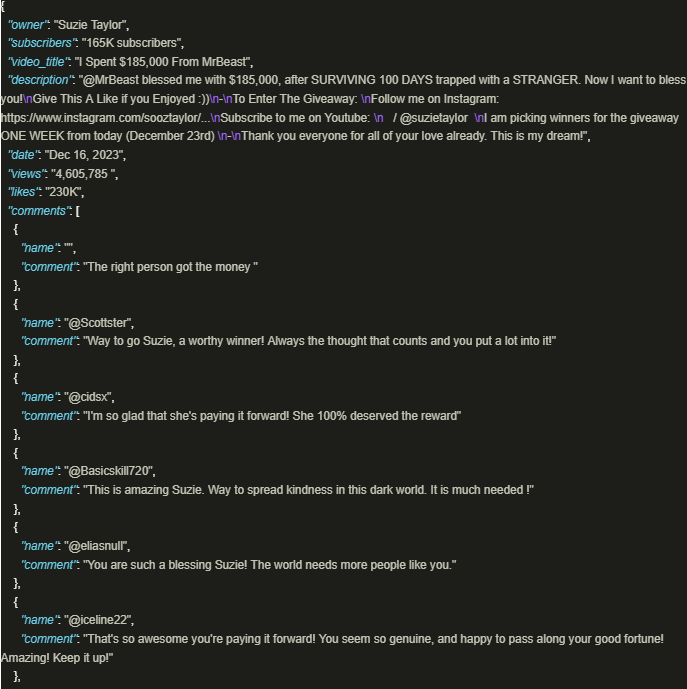
 zh
zh  English
English  Español
Español  Tiếng Việt
Tiếng Việt  Deutsch
Deutsch  Українська
Українська  Português
Português  Français
Français  भारतीय
भारतीय  Türkçe
Türkçe  한국인
한국인  Italiano
Italiano  Gaeilge
Gaeilge  اردو
اردو  Indonesia
Indonesia  Polski
Polski YouTube 创作者必须评估自己视频的表现;分析正面和负面评论,并将自己的内容与同类或不同类的其他内容进行比较,这些都是必不可少的。
对于创作者来说,手动筛选发布的视频既乏味又耗时。这正是 YouTube 搜索脚本的价值所在。我们将在本指南中开发一个 YouTube 脚本,用于自动完成数据收集过程。
为了让脚本正常运行,我们需要安装一些软件包。首先要安装的软件包是 selenium-wire,它是 Selenium 的扩展,可实现正确的代理配置,而 Selenium 本身则提供了必要的类和模块。要安装这些软件包,请在命令界面执行以下命令:
pip install selenium-wire selenium blinker==1.7.0现在,让我们把重点放在进口产品上。
在此阶段,重要的是要导入脚本中用于与网络元素交互的库和包。此外,我们还应加入数据处理和运行时管理模块,以确保脚本的高效执行。
from selenium.webdriver.chrome.options import Options
from seleniumwire import webdriver as wiredriver
from selenium.webdriver.common.keys import Keys
from selenium.webdriver.common.by import By
from selenium.webdriver.support.wait import WebDriverWait
from selenium.webdriver.support import expected_conditions as EC
from selenium.webdriver.common.action_chains import ActionChains
import json
import timejson 模块有助于将提取的数据转换为格式正确的 JSON 数据,确保最佳的数据呈现。尽管掩盖了我们的 IP,但时间模块对于为操作引入随机性、防止出现类似脚本的行为至关重要。
此外,该模块对于确保我们从页面中提取数据所需的元素已加载至关重要。其余的导入由必要的类或子模块组成,这些类或子模块将执行不同的操作,并将在代码的后续章节中详细说明。
每当你使用 python 脚本运行一个硒实例时,脚本就会使用我们的 IP 地址来执行我们想要执行的任何活动。这是非常危险的,尤其是像 YouTube 这样的网站,它们有严格的政策禁止从网站上获取信息,你可以查看它们的 robots 文件以获得更好的参考。这样做的后果可能是暂时限制你的 IP 访问 YouTube 内容。
为了避免这一切,我们需要做几件事。我们需要创建 3 个变量,用于存放我们将通过其访问页面的代理的详细信息。然后,我们创建一个选项变量 chrome_options,并将其传递到 Chrome WebDriver 实例中,这样 Selenium 就能知道刮擦时要使用哪个代理。我们将代理详细信息作为参数传入 chrome_options,代理就设置好了。
# 指定带有用户名和密码的代理服务器地址
proxy_address = ""
proxy_username = ""
proxy_password = ""
# 使用代理和身份验证设置 Chrome 浏览器选项
chrome_options = Options()
chrome_options.add_argument(f'--proxy-server={proxy_address}')
chrome_options.add_argument(f'--proxy-auth={proxy_username}:{proxy_password}')
# 使用 selenium-wire 创建 WebDriver 实例
driver = wiredriver.Chrome(options=chrome_options)创建一个名为 "youtube_url_to_scrape "的变量,用于存储 YouTube 登陆页面的 URL。然后在 "driver.get() "方法中使用该变量,引导 Selenium 打开特定页面进行抓取。运行脚本时,执行此操作将打开一个单独的 Chrome 浏览器窗口。
youtube_url_to_scrape = ""
# 利用 selenium-wire 的增强功能执行 Selenium 自动化
driver.get(youtube_url_to_scrape)
接下来,我们定义 "extract _information() "函数,顾名思义,它可以从页面中提取必要的信息。
必须确保页面上的所有元素都已加载。为此,我们使用 WebDriverWait 类暂停脚本,至少等到 "更多 "按钮可用并被点击(在 "元素 "变量下实现)。一旦按钮可用,Selenium 就会执行 JavaScript 点击操作,从而访问视频的完整描述。
为了解决前面提到的动态评论问题,我们正在实施一个解决方案来消除任何相关问题。我们使用操作类和时间模块,每 10 秒向下滚动两次,确保尽可能多地抓取评论。这种积极主动的方法可以防止与动态加载内容相关的潜在瓶颈问题。
def extract_information() -> dict:
try:
element = WebDriverWait(driver, 15).until(
EC.presence_of_element_located((By.XPATH, '//*[@id="expand"]'))
)
element.click()
time.sleep(10)
actions = ActionChains(driver)
actions.send_keys(Keys.END).perform()
time.sleep(10)
actions.send_keys(Keys.END).perform()
time.sleep(10)使用selenium webdriver 搜索元素有多种方法。你可以通过 ID、CLASS_NAME、XPATH 等进行搜索。在本指南中,我们将综合使用多种方法。
XPATH 是一种更复杂但基于模式的系统,用于在搜刮过程中定位变量。它被认为是最复杂的;不过,Chrome 浏览器已将其变得简单。
使用 Chrome 浏览器的检查工具查看代码时,只需右键单击即可复制 XPATH。复制后,您可以使用 `find_elements` 函数来识别包含所需信息(如视频标题、描述等)的所有元素。
需要注意的是,页面上的某些元素可能共享类似的属性,这可能导致 "find_elements() "调用返回的是列表而不是字符串。在这种情况下,您必须检查列表,找出相关信息的索引并提取文本。
最后,会返回一个名为 "data "的字典变量,该变量包含了刮擦过程中获取的所有信息,因此是后续章节的重要内容。
video_title = driver.find_elements(By.XPATH, '//*[@id="title"]/h1')[0].text
owner = driver.find_elements(By.XPATH, '//*[@id="text"]/a')[0].text
total_number_of_subscribers = \
driver.find_elements(By.XPATH, "//div[@id='upload-info']//yt-formatted-string[@id='owner-sub-count']")[
0].text
video_description = driver.find_elements(By.XPATH, '//*[@id="description-inline-expander"]/yt-attributed-string/span/span')
result = []
for i in video_description:
result.append(i.text)
description = ''.join(result)
publish_date = driver.find_elements(By.XPATH, '//*[@id="info"]/span')[2].text
total_views = driver.find_elements(By.XPATH, '//*[@id="info"]/span')[0].text
number_of_likes = driver.find_elements(By.XPATH, '//*[@id="top-level-buttons-computed"]/segmented-like-dislike-button-view-model/yt-smartimation/div/div/like-button-view-model/toggle-button-view-model/button-view-model/button/div')[
1].text
comment_names = driver.find_elements(By.XPATH, '//*[@id="author-text"]/span')
comment_content = driver.find_elements(By.XPATH, '//*[@id="content-text"]/span')
comment_library = []
for each in range(len(comment_names)):
name = comment_names[each].text
content = comment_content[each].text
indie_comment = {
'name': name,
'comment': content
}
comment_library.append(indie_comment)
data = {
'owner': owner,
'subscribers': total_number_of_subscribers,
'video_title': video_title,
'description': description,
'date': publish_date,
'views': total_views,
'likes': number_of_likes,
'comments': comment_library
}
return data
except Exception as err:
print(f"Error: {err}")
def organize_write_data(data:dict):
output = json.dumps(data, indent=2, ensure_ascii=False).encode("ascii", "ignore").decode("utf-8")
try:
with open("output.json", 'w', encoding='utf-8') as file:
file.write(output)
except Exception as err:
print(f"Error encountered: {err}")函数 `organize_write_data()` 将返回的 `data` 作为输入,并将其整理为格式化的 JSON 结构。然后,它将整理好的数据写入名为 "output.json "的输出文件,同时处理文件写入过程中可能出现的错误。
到目前为止,这里是我们刮擦程序的完整代码:
from selenium.webdriver.chrome.options import Options
from seleniumwire import webdriver as wiredriver
from selenium.webdriver.common.keys import Keys
from selenium.webdriver.common.by import By
from selenium.webdriver.support.wait import WebDriverWait
from selenium.webdriver.support import expected_conditions as EC
from selenium.webdriver.common.action_chains import ActionChains
import json
import time
# 指定带有用户名和密码的代理服务器地址
proxy_address = ""
proxy_username = ""
proxy_password = ""
# 使用代理和身份验证设置 Chrome 浏览器选项
chrome_options = Options()
chrome_options.add_argument(f'--proxy-server={proxy_address}')
chrome_options.add_argument(f'--proxy-auth={proxy_username}:{proxy_password}')
# 使用 selenium-wire 创建 WebDriver 实例
driver = wiredriver.Chrome(options=chrome_options)
youtube_url_to_scrape = ""
# 利用 selenium-wire 的增强功能执行 Selenium 自动化
driver.get(youtube_url_to_scrape)
def extract_information() -> dict:
try:
element = WebDriverWait(driver, 15).until(
EC.presence_of_element_located((By.XPATH, '//*[@id="expand"]'))
)
element.click()
time.sleep(10)
actions = ActionChains(driver)
actions.send_keys(Keys.END).perform()
time.sleep(10)
actions.send_keys(Keys.END).perform()
time.sleep(10)
video_title = driver.find_elements(By.XPATH, '//*[@id="title"]/h1')[0].text
owner = driver.find_elements(By.XPATH, '//*[@id="text"]/a')[0].text
total_number_of_subscribers = \
driver.find_elements(By.XPATH, "//div[@id='upload-info']//yt-formatted-string[@id='owner-sub-count']")[
0].text
video_description = driver.find_elements(By.XPATH,
'//*[@id="description-inline-expander"]/yt-attributed-string/span/span')
result = []
for i in video_description:
result.append(i.text)
description = ''.join(result)
publish_date = driver.find_elements(By.XPATH, '//*[@id="info"]/span')[2].text
total_views = driver.find_elements(By.XPATH, '//*[@id="info"]/span')[0].text
number_of_likes = driver.find_elements(By.XPATH,
'//*[@id="top-level-buttons-computed"]/segmented-like-dislike-button-view-model/yt-smartimation/div/div/like-button-view-model/toggle-button-view-model/button-view-model/button/div')[
1].text
comment_names = driver.find_elements(By.XPATH, '//*[@id="author-text"]/span')
comment_content = driver.find_elements(By.XPATH,
'//*[@id="content-text"]/span')
comment_library = []
for each in range(len(comment_names)):
name = comment_names[each].text
content = comment_content[each].text
indie_comment = {
'name': name,
'comment': content
}
comment_library.append(indie_comment)
data = {
'owner': owner,
'subscribers': total_number_of_subscribers,
'video_title': video_title,
'description': description,
'date': publish_date,
'views': total_views,
'likes': number_of_likes,
'comments': comment_library
}
return data
except Exception as err:
print(f"Error: {err}")
# 将数据记录为 JSON 格式
def organize_write_data(data: dict):
output = json.dumps(data, indent=2, ensure_ascii=False).encode("ascii", "ignore").decode("utf-8")
try:
with open("output.json", 'w', encoding='utf-8') as file:
file.write(output)
except Exception as err:
print(f"Error encountered: {err}")
organize_write_data(extract_information())
driver.quit()输出结果如下

如果使用精心制作的脚本,利用代理来确保遵守平台政策和法规,那么安全地利用 YouTube 的丰富信息将大有裨益。上述方法有利于负责任地提取数据,并降低平台施加的潜在限制风险。
评论: 0